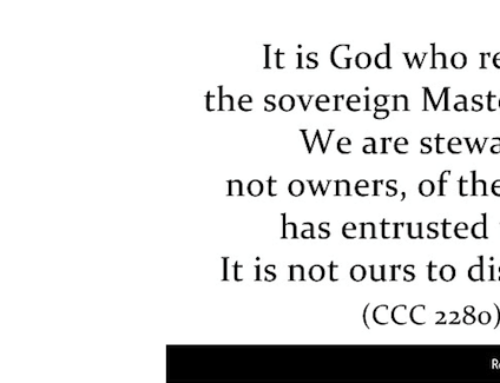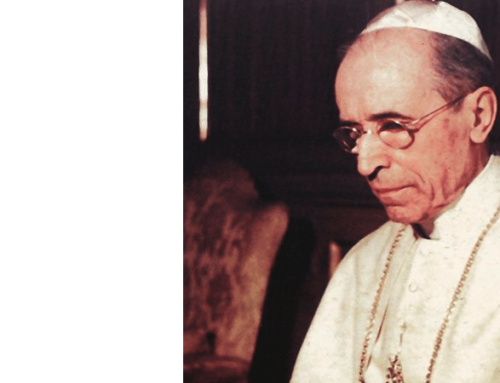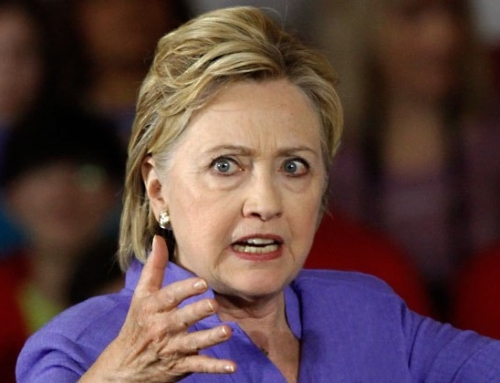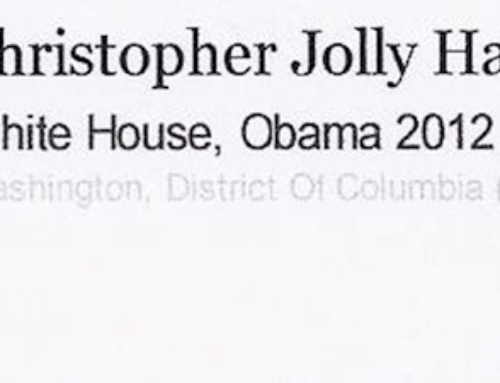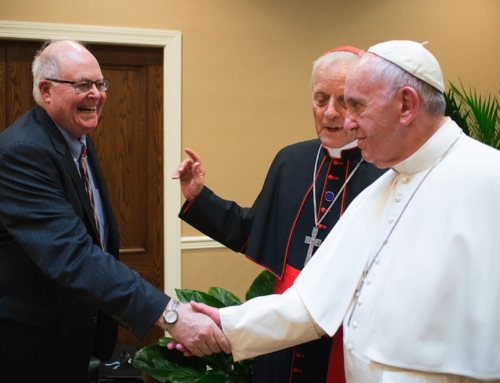by Ronald Rychlak
(Catalyst 5/2004)
During World War II and for years after it ended, Pope Pius XII was heralded as a staunch opponent of the Nazis and a champion of their victims. Then in 1963, as the result of a piece of fiction written by German playwright Rolf Hochhuth, a controversy arose about whether the Pope had been sufficiently outspoken about Nazi atrocities. One of the earliest papal critics of this era was Robert Katz. In his 1967 Death in Rome and in his 1969 Black Sabbath, Katz severely criticized Pope Pius XII for failing to take a firmer stand in opposition to the Nazis.
After the controversy re-erupted in the past few years, with the publication of several new books, authors like John Cornwell and Susan Zuccotti were justifiably criticized for relying on Katz’s work, which pre-dated the extensive release of Vatican documents on this subject.
Now, in The Battle for Rome: The Germans, the Allies, the Partisans, and the Pope (Simon and Schuster: New York 2003) Katz re-asserts his old charges. Not only does he cite his out-dated books for authority, but coming full circle, he relies upon Zuccotti and Cornwell who had relied upon him! In fact, at one point (p. 54), Katz refers to a charge made by “one historian.” Flipping to the endnotes, one finds an abbreviation. Only by further flipping to Katz’s key does the reader learn that Katz’s “historian” is journalist (not historian) John Cornwell and his discredited book, Hitler’s Pope.
One of the reasons why serious scholars have avoided Katz’s earlier books is because of a lawsuit that was filed by Pope Pius XII’s niece, Elena Rossignani. The Italian Supreme Court ruled that: “Robert Katz wished to defame Pius XII, attributing to him actions, decisions and sentiments which no objective fact and no witness authorized him to do.” Katz was fined 400,000 Lire and given a 13-month suspended prison sentence.
In his new book, Katz discounts that lawsuit, noting that because of an amnesty, the litigation was ruled moot. That may be a legal defense, but it does not negate the two separate findings on the merits against Katz, and those findings should be sufficient to warn readers about the legitimacy of (and motivation behind) Katz’s work.
Katz focuses on the period when German troops occupied Rome. The first important Vatican-related event took place in October 1943, when the Nazis rounded up about 1,200 Roman Jews for deportation. Katz concludes that the Allies had advance notice of the planned roundup and that Pope Pius had at least an unsubstantiated warning of it.
Katz reports that a copy of a German telegram revealing the Nazi order for the roundup of Jews was passed on to President Franklin Roosevelt. Only by consulting the notes at the back of the book, however, does one learn that the telegram reached Roosevelt nearly three months after the roundup
Katz’s case against Pope Pius XII, who had offered gold to pay a ransom to the Germans to prevent deportations, is even weaker. (Katz even faults Pius for making this offer, because it may have dissuaded some Jews from going into hiding!)
Katz claims that the German Ambassador to the Holy See, Ernst von Weizsaecker urged the Pope to make “an official protest” on the day that the Jewish people were arrested. In support of this claim, Katz cites a telegram sent by the Consul at the German embassy to the Quirinal [seat of the Italian government] to the Foreign Office in Berlin. This telegram, however, was sent nine days before the roundup and said nothing about any plan urged on the Vatican.
In a conversation that Weizsaecker had with the Vatican Secretary of State on the day of the arrests, the ambassador expressly urged the Pope not to openly protest, since a protest would only make things worse. In fact, thanks in part to Vatican intervention, about 200 prisoners were freed. Moreover, there were no further mass arrests of Roman Jews (thousands of whom—with papal support—went into hiding in Church properties). Obviously, Pius acted with the best interest of the victims in mind.
The second event on which Katz focuses took place on March 23, 1944 after Italian partisans set off a bomb which killed 33 members of the German police. Hitler ordered the immediate execution of ten prisoners for every soldier killed. Within hours, 335 prisoners (most of whom were not Jewish; one was a priest) were led to the catacombs on the outskirts of Rome and shot. The massacre took place in complete secrecy.
Katz argues that the Pope knew of the retaliation in advance but that he did nothing to help. He cites as “proof” a memorandum that was received at the Vatican on March 24, about five hours before the prisoners were killed. That memo, which was published by the Vatican in 1980, said that “it is however foreseen that for every German killed 10 Italians will be executed.”
First of all, this memo probably did not make it all the way to the Pope prior to the executions. More importantly, Pope Pius XII certainly was well aware of the likelihood of brutal Nazi retaliation before he got this memo, which provided no specific details or new information. In fact, historian Owen Chadwick cited the document as proof that Pius XII obviously did not know details of the reprisal.
When the memorandum made its way to him, Pius sent a priest to obtain more information and release of the prisoners. The Gestapo chief of police, however, would not receive the Pope’s messenger. The executions were already underway. That officer (Herbert Kappler) testified during his post-war trial that “Pope Pius XII was not aware of the Nazis’ plans before the massacre.”
Katz’s efforts to defame Pius XII are evident from the very beginning of this book. The text starts with a report from the Roman police chief on the activity of the clergy and Catholic Organizations. It says, “The clergy continues to maintain an attitude of cooperation with the Government.” Since the book is about the era of Nazi occupation, one might think that the Church was in cahoots with the Germans. The date of the report, however, is prior to the Nazi occupation.
Katz suggests that Pius should have approved of rebel efforts to murder Nazis. At the same time, he suggests that the Pope should have participated in a funeral for murdered Nazis. He also criticizes Pius for his efforts to bring about peace. Additionally, Katz seems to think that the Pope should have behaved differently when the victims were Italian Catholics as opposed to Jews. Can you imagine the justifiable criticism if the Pope had done that?
Katz would have the reader believe that Sir Francis D’Arcy Osborne, British Minister to the Holy See from 1936 to 1947, was a critic of Pius. In fact, following the war Osborne wrote that “Pius XII was the most warmly humane, kindly, generous, sympathetic (and, incidentally, saintly) character that it has been my privilege to meet in the course of a long life.” Similarly, Katz wants us to believe that the U.S. representative in the Vatican, Harold Tittman, was a papal critic. Tittman’s son, however, is working on his father’s memoirs, and he reports that the U.S. representative held a very favorable opinion of Pius XII’s policies. Most preposterous of all is the attempt to suggest that Domenico Cardinal Tardini held Pius in low regard. One only need consult Tardini’s loving tribute, Memories of Pius XII, to see the falseness of that charge.
Katz contends that Pius was prejudiced not only against Jews but also against blacks. He cites a British memorandum indicating that after the liberation of Rome, the Pope requested that “colored troops” not be used to garrison the Vatican. This canard stems from a report the Pope received about French Moroccan troops. They were particularly brutal, raping and looting whereever they went. The Pope did not want these specific soldiers stationed in Rome (or anywhere else). He expressed his concerns about these men to British Ambassador Osborne, who broadened the statement in his cable back to London, saying that the Pope did not want “colored troops” stationed at the Vatican.
The Pope’s concern about these specific French Moroccan troops is made clear in a declassified confidential memorandum from the OSS, an article that appeared in the Vatican newspaper, and a message sent from the Vatican to its representative in France. None of these documents make reference to race, just the Pope’s concern over these specific French Moroccan troops. (Although Katz did not know how they played into this story, even he noted the outrageous brutality of these soldiers.)
Katz assails Pope Pius IX as an anti-Semite; incorrectly asserts that Pius XII favored the Germans over the Soviets in World War II; calls Pius XII pompous; mocks the Chief Rabbi of Rome (who praised Pius XII); accepts self-serving testimony from Nazi officers over Jewish and Catholic witnesses; repeats stories that have been shown to be false; gives inaccurate interpretations to papal statements; cites rumors that suggest the Pope was prepared to flee Rome; and takes every cheap shot that he can.
Of those who support Pius XII, Katz writes: “The Pope’s defenders can do no better than cite decades-old research of deflated credibility….” That, of course, is preposterous. All kinds of new evidence has come to light in the past year with the opening of new archives. Every bit of it supports the view that Pius XII and the Vatican leadership were opposed to the Nazis and did what they could to help all victims, Jewish or otherwise.
One final error made by Katz: He reports at the end of the book that Ronald J. Rychlak is a “non-Catholic lawyer and professor at the University of Mississippi School of Law, now Pius’s staunchest supporter.” I am and always have been Catholic.
Ron Rychlak is a Professor of Law and the Associate Dean for Academic Affairs at the University of Mississippi School of Law. His is the author ofHitler, the War, and the Pope (Our Sunday Visitor, 2000).


